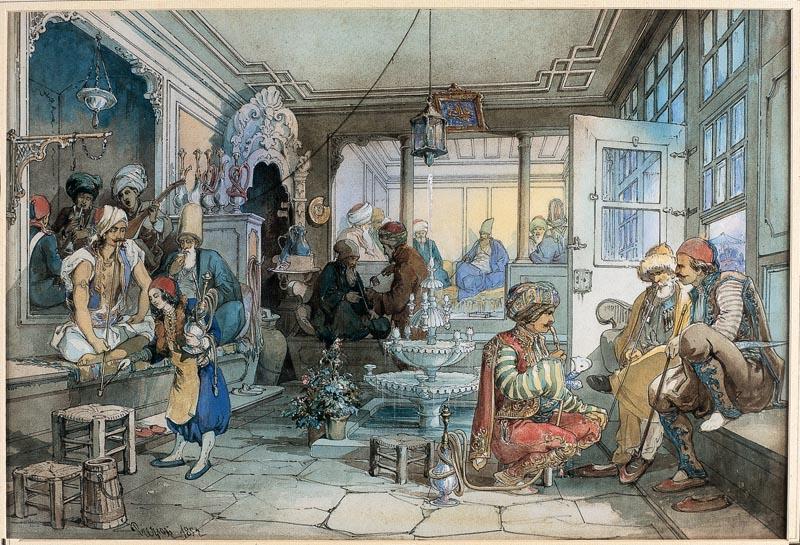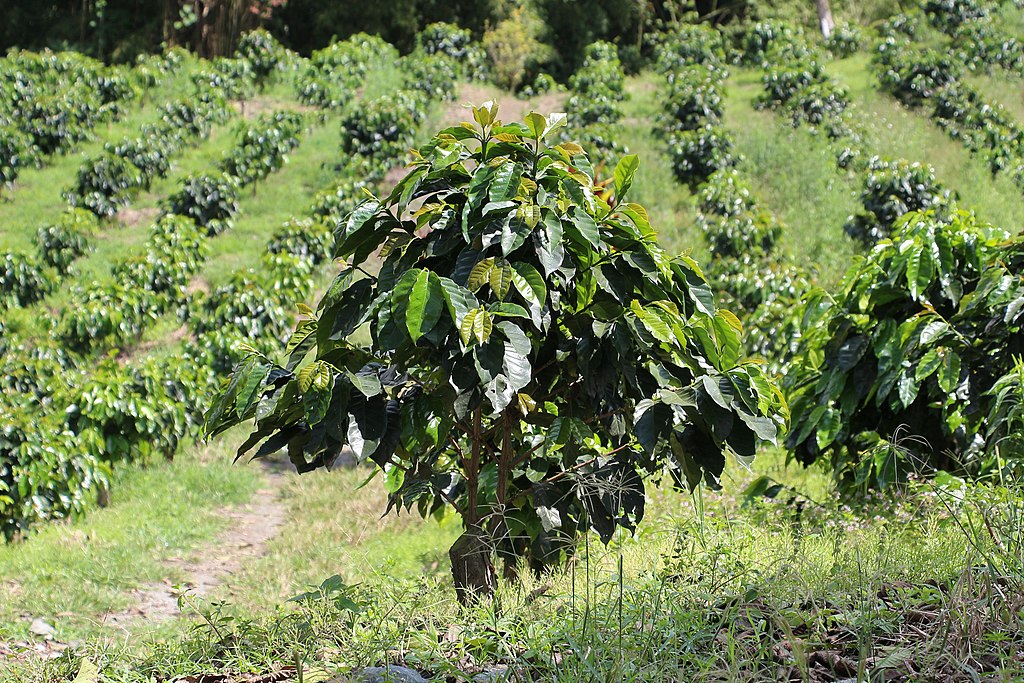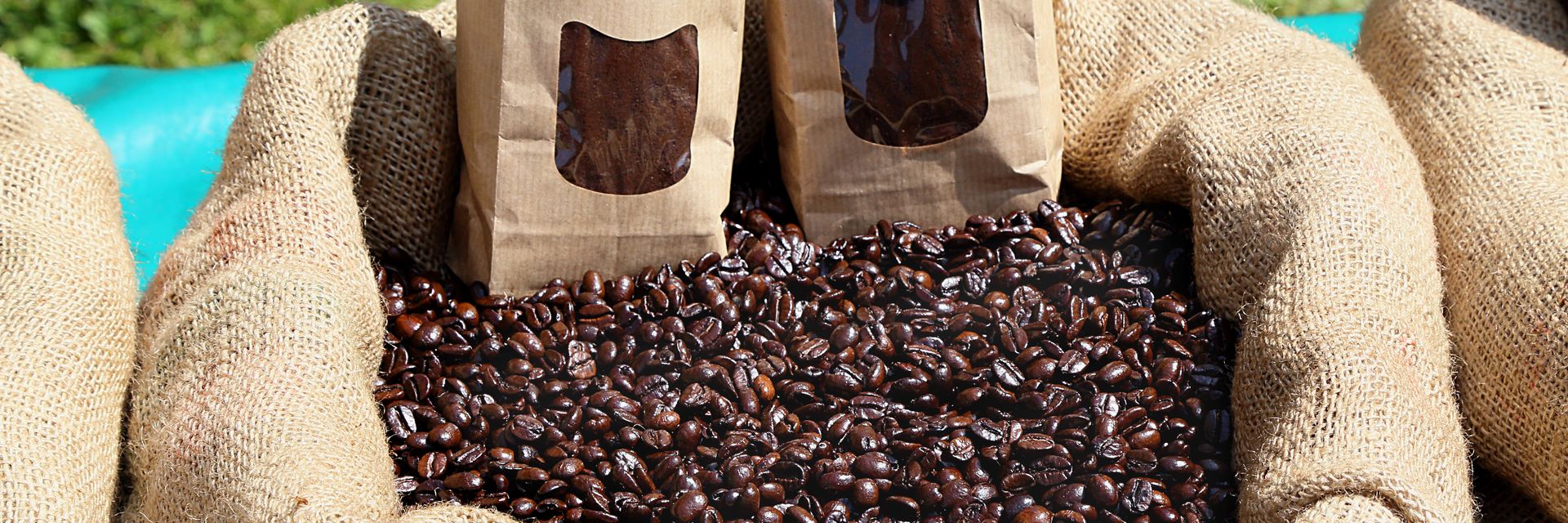Coffee fuels more than just your morning commute and midday pick-me-up. It has empowered civilizations, economies, and colonial adventures. The history of coffee reveals both positive legacies, such as the spread of Enlightenment ideals – and profoundly negative ones, such as the blight of slavery.
◊
Why do we love coffee so much? In fact, the next question asks itself: Why do we seem to need it so much? Here’s a quick quiz: Have you had your java fix today? Yes? How many cups so far? One recent study on the effects of coffee drinking found some test subjects consuming as many as 25 cups of coffee in a day – and without damaging their hearts!
Even if you avoid coffee, you may still be consuming a couple doses of caffeine daily from other sources, such as tea and chocolate. And, of course, caffeine puts the “pop” in many types of soft drink. Plus there are the so-called energy drinks, many of which are basically flavored caffeine delivery systems. (Care for some Extra Strength 5-hour Energy, with an out-of-the-park 242 mg of caffeine per serving?)

(Image courtesy of Petr Kratochvil, via Wikimedia)
Caffeine has a grip on most of our bodies and minds, and it’s been this way for hundreds of years. The legacy of coffee involves strains both light and dark, from stimulating progressive thought in the Old World and New to spreading the dark stain of slavery around the world. Let’s explore both, beginning with a quick tour through coffee’s history.
The Ancient Economy of Coffee: Building the World’s First Monopoly
Coffee plants grew wild on the plains of Ethiopia in eastern Africa for millennia, but the first records we have of the coffee beverage come from the 14th century on the Arabian Peninsula, in the area now known as Yemen. Around that time, coffee began to be intentionally cultivated for the bean at the heart of its fruit, called a “cherry” for its dark-red hue. Initially, the bean was removed from the fruit and processed by being parched, then boiled, making them fragrant and ready to be brewed into the coffee beverage, called qahveh in Arabic.
As stimulating and delicious as it must have been to imbibers who’d never tried it before, the earliest version of Arabic coffee didn’t look or taste much like today’s brew. The crucial difference – to blanch, then roast the beans – was the innovation of the Persians, who really knew how to make a rich, fragrant cup.
The Arabs who controlled the land where coffee was grown also controlled the means of production. And, soon enough, they controlled the method of delivery, through the beans that fueled the rise of coffee houses. If their intention was to control the supply chain from beginning to end, they certainly succeeded (and with a pretty remarkable vertically integrated corporate structure!)
Another clever element of the Arabian model was that the beans on the market were sterilized in their production and so could not be used to set up rival plants for cultivation. Since coffee plants can only be grown from fertile seeds, selling only infertile, processed beans guarded the “intellectual property” of the coffee bean processing method.
The coffee growers of southern Arabia cornered the market and set up what was one of the world’s first monopolies. Controlling all aspects of access to coffee, from the plant in the ground to the steaming cup in your hands and the establishment where you were drinking, the Arabs set into motion the mechanics of a capitalistic market that evolved soon enough into the colonialist mode of resource exploitation.
Coffee Houses Bring Free Thinking to an All-Male Culture
As the craving grew among early caffeine lovers, a novel means of distribution quickly arose: the coffee house. These qahveh khaneh, as they were called in Arabic, popped up along the primary pilgrimage routes between Mecca, on the Arabian Peninsula, and other parts of the inhabited world.
Given the strictly male-dominated culture of the day, the first coffee houses were frequented only by men – but, perhaps paradoxically, they also added a flavor of egalitarianism among their patrons and the broader society. In the Middle East, the custom was to welcome all travelers as guests regardless of their backgrounds. So, in this culture of travelers, all ranks and classes were served together.
The results of this new cultural community were salutary. The spirit of the coffee house, and its rich, dark “wine of Araby,” eventually expanded into urban centers throughout the region, then in the world beyond. Just add mobile electronic devices – and women – and you have a scene not at all unlike today’s contemporary coffee house scene.
With the dispersion of information creating a new “network” among patrons as well as other coffee houses, it can reasonably be said that this “open system” of “distributed data centers” was the original Internet!
Coffee Houses Export Enlightenment Ideas
Within another century or so, these newly popularized houses of free-wheeling camaraderie were introduced to lands to the west. By the beginning of the 17th century, coffee and its social customs had begun to be integrated into the social and cultural worlds of the most sophisticated residents of Western Europe’s great cities: Paris, Vienna, and London, among others. In these lands, where beer and wine were daily staples of the diet at the time, coffee came as a virtually unprecedented novelty. Rather than retiring to the ale-house or the pub and ending up inebriated, habitués of Viennese Kaffeehäuser and Parisian cafés could talk all night and still feel full of vigor and energy.

Istanbul Cafe, by Amedeo Presziosi
(Image courtesy of Wikipedia)
Environments like these were fertile ground for the cultivation of ideas. Patrons found that engaging in conversation in an egalitarian fashion made the spread of new ideas desirable and often delightful. And there was much more to savor than good coffee and conversation, for culture grew alongside these new daily habits.
The spirit that allowed for the free and easy sharing of ideas and the rise of new, idealized notions of humankind was inherent to the coffee house culture of the 18th century and to the advent of the Enlightenment. To see the entanglement of Enlightenment thought and politics with the expansion of coffee house culture in the 1700s, look no further than Benjamin Franklin, who held his political meetings and discussions exclusively in coffee houses when he was a resident of London. And no less a figure than Voltaire, a citizen of Paris, was said to be so obsessed by coffee that he drank 40 to 50 cups of it on a daily basis.
The 18th century revolutions of both France and the United States were birthed, developed, refined, and planned in coffee houses. The U.S. had been a tea-drinking nation until the Boston Tea Party of 1773; after then it became a sign of patriotism to toss back cups of joe morning, noon, and night, a zealous habit that has lasted through the present day.
Tragically, the impact of coffee on society was not altogether salutary. In fact, the increasing demand for coffee stimulated not just good conversation and social progress, but also a market for the slave labor that produced the coffee. At the same time that free men of means were raising their cups in celebration of the “fraternity of man,” workers in the coffee supply economy were toiling under some of the worst and most oppressive conditions imaginable.
Coffee’s Dark Side: the Rise of Colonialism and Oppressive “Export Economies”
With the rapid growth in popularity of this new “dark wine” from the fruit of the coffee plant, an expanding market was opening up previously unknown opportunities. It was only a matter of time before speculators and government-sponsored agents in the West began to seek ways to exploit this new and valuable commodity. By the mid-17th century, they were looking at tropical sites for cultivating the highly desirable crop.
Only very warm locations were suitable, because the delicate coffee plant could not survive a frost. So the Europeans, starting with the Dutch and quickly including the British and French, created unprecedented “export economies” in tropical areas, with coffee joining tea as a fabulously profitable cash crop.
This pattern would gradually be applied to a diverse roster of addictive substances grown for export: Tobacco, sugar, cocoa, and more were all cultivated in far-flung spots around the globe to supply wealthier Westerners with goods they craved, at the lowest price possible. And how best to keep the cost down? Well, cheap labor, of course – and the cheapest workers of all were the ones you don’t have to pay, i.e., slaves.
Dark Brew: Slavery and the Expansion of Coffee Culture
It is a tragic irony that coffee both enhanced the desire for liberty, freedom, and equality among Western coffee house patrons, while the supply of that prized product was at the same time enabled by slavery. Coffee houses, these bastions of liberty and equality, were supplied by the labor of slaves toiling in the Caribbean and elsewhere to produce a pleasant social lubricant for the privileged class of free men.
Explore MagellanTV and our 1,500+ documentaries!
Slavery didn’t start with coffee, but the expanded production of coffee in the late 17th and early 18th centuries exacerbated the spread of slavery from the Old World to the New. Enslavement and forced labor on plantations became the most expedient – and, to our contemporary eyes, most abhorrent – means of filling the civilized world’s coffee cups.
Starting in the mid-16th century, Brazil and its exports, including rubber and sugar, were given a boost by imported slave labor. The importation to the New World of African slaves first took root in Brazil, and later migrated through the Caribbean and, eventually, to the United States.
Coffee production grew rapidly as Western powers sent emissaries throughout conquered regions to find optimal soil for coffee plants. The result was the establishment of vast plantations as cultivation centers, ruled by absolute domination and reliant on European military might.
The Dutch were early to this exploitation party with coffee cultivation on the colonized island of what is now known as Sri Lanka, and, in 1696, the establishment of the crop in Java, progenitor of the common slang name for coffee. The Dutch also brought African slaves to the New World, first to Brazil and, around 1720, to the Caribbean island of Martinique, where the Americas’ first coffee plantations were established.
Around the same time, France jumped quickly into the growing market, importing slaves from Africa to cultivate coffee on Réunion Island in the Indian Ocean, and Haiti in the Caribbean.
Coffee Today: The Sweet and the Bitter
Coffee eventually became, and has remained, the most consumed beverage in the developed world. It is still produced only in the tropics, in lands with a history of slavery in the service of export crops including the two staples of our caffeinated society: coffee and sugar, which millions can attest go together perfectly.
Even now, when progressive production policies like fair-trade are in ascendance, harvesting and processing coffee requires enormously difficult labor amid harsh conditions. Additionally, growers both large and small are being affected by both worldwide upheavals in the market and climate change, which is affecting crop yields.

Colombian coffee field
(Image courtesy of Bernard Gagnon, via Wikimedia)
In Guatemala, for example, effects of the 10-year slide in coffee prices have financially ruined large numbers of coffee farmers and workers, who have, to a large extent, fueled the increases in numbers of Guatemalans deciding to migrate to the United States.
Policies recently enacted in Mexico and along the U.S./Mexico borders have contributed to conditions becoming ever more dire for Guatemalan and other Central American coffee producers and the massive numbers of workers currently being displaced by market and cultivation changes.
So, as we drink our daily brew, let’s try to remember both coffee’s highest moments in the development of our culture as well as the sacrifices made by so many people around the world to get this precious brew to our cups and lips.
Ω
Kevin Martin is Senior Writer for MagellanTV. He writes on a wide variety of topics, including outer space, the fine arts, and modern history. He has had a long career as a journalist and communications specialist with both nonprofit and for-profit organizations. He resides in Glendale, California.
Title image: A Bag of Roasted Coffee Beans by Jamain via Wikimedia Commons.

